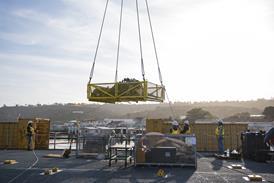Andrew Chuter/London and Graham Warwick/WASHINGTON DC, Data supplied by Air Transport Intelligence
After a Farnborough air show at which airliner sales exceeding $20 billion were announced, any talk of recession seems like scaremongering. But the air transport industry is already bracing itself for the next downturn - the only questions are when it will happen, how long it will last and how deep it will be.
Air transport activity closely tracks the global economy, which is proving more robust this time round. So far it has survived the Asian crisis and Russia's economic turmoil, either of which would be enough to trigger a global recession were it not for the remarkable strength of the US economy, which seems impervious even to the adverse effects of the country's domestic scandals.
Economists are still predicting a downturn some time within the next two to three years, but analysts do not expect the impact on the air transport industry to be as great as last time - at least for the aircraft manufacturers. Predictions for the maintenance, repair and overhaul industry are more difficult to make.
Whereas the buying spree that came to an abrupt end in the early 1990s was predominantly for widebody aircraft to support growth in long-haul markets, this time round, the boom has been principally in narrowbody aircraft to replace ageing short-haul fleets. Analysts, therefore, predict that the bulk of orders and options already in hand should survive any likely downturn.
Not that this will help the overhaul industry in the short term, as none of these new aircraft will need heavy maintenance for several years. It could, instead, make the cost pressures more acute during any downturn, as airlines seek to free up funds for new aircraft by cutting back on operating expenses.
MARKED CHANGES
The third-party maintenance industry has changed markedly, however, since the recession of the early 1990s, and the companies that have emerged are better equipped to survive the next downturn in the business cycle. This is not only the result of being leaner and meaner - which generally the sector has become - but also because the more far-sighted companies now have most of their customers tied to long-term contracts, giving some insulation against the ups and downs of the world economy.
The last downturn differed for previous cycles in that, when profits returned, airlines did not let up on cost cutting. Shocked into action by the scale of their losses in the recession of the early 1990s, airlines set about focusing on what they do well, while outsourcing those activities which others can do more efficiently.
That trend did not end when red turned to black on the balance sheets and today, when revenues and profits are back to record levels, airlines are still looking for deals that save them money - and industry is still responding.
Those continuing cost pressures have at last pushed the airlines to begin realising that maintenance is performed most efficiently by those which specialise in it. One of the uncertainties of the next recession is whether the move the third-party maintenance will be accelerated by the carriers' need to continue to cut costs in their non-core operations.
MAINTENANCE DEFERRAL
Even if the trend does continue, overhaul companies can expect to face a tough time in any downturn, as airlines are likely to defer as much routine maintenance as regulations will allow. So, while the longer term trend may still be towards more third-party maintenance, players are likely in the short term to see their margins come under increasing pressure.
For the time being, however, the uncertainty gripping the globe has had no discernable impact on the maintenance business. Regard-less of whether or not that uncertainty moves into recession, there will continue to be casualties in this highly competitive market as companies change strategies, or simply find the going too tough.
Generally, business continues to be good for the third-party providers. Hourly maintenance rates have increased to levels not seen for several years, and European industry capacity is sufficiently tight that some airlines are having trouble finding a home for heavy maintenance work this coming winter.
Against this background, European industry leaders are looking at the wider picture. The maintenance sector in Europe will not be immune to the wider globalisation of the aviation industry, and the region's leading players, such as FLS Aerospace, Lufthansa Technik and SR Technics, can be expected to be at the forefront of any rationalisation as the industry moves towards the creation of the eight or nine large companies that are expected to dominate the sector by around 2005.
The first signs of that rationalisation can already be seen with FLS' move to acquire the TEAM Aer Lingus maintenance operation in Dublin from the Irish flag carrier.
Generally, however, global restructuring of the third-party maintenance sector has hardly begun, and an industry recession may prove to be just the catalyst needed to get the process under way in earnest. Only when margins come under pressure and overcapacity looms will the asking price for acquisitions start to fall.
The influence of customer globalisation has also started to pose questions for the maintenance-related industry. The behaviour of global groupings such as the United Airlines/Lufthansa-led Star Alliance and the new American Airlines/British Airways-led Oneworld venture - and particularly how they use their combined resources and wield their combined buying power - will affect the maintenance providers.
A maintenance subsidiary of an airline in one of the existing smaller alliances is already using its new-found power to influence the placing of contracts, and service providers are unclear just where this trend might end.
Star Alliance partners Air Canada, Lufthansa and United have already formed AirLiance Materials, a joint venture tasked with redistributing surplus aircraft parts. Three partners, with a combined fleet of over 1,000 jet aircraft, account for 10% of the world's surplus parts market - valued at $1.3 billion annually - making the venture, formed in May, a major player.
If the alliances combine to exploit their in-house maintenance resources more efficiently, or market them more effectively, or combine to wield their buying power for outsourced services more aggressively, the outcome for the third-party sector could prove dramatic.
GLOBAL CONSOLIDATION
The threat of the aircraft manufacturers getting in on the maintenance act seems to have receded, however, although the engine makers have continued to consolidate their hold on the global aftermarket. Boeing appears to have backed off from plans to form maintenance joint ventures around the world, possibly warned off by the strongly negative reaction of airline customers to its powerful training partnership with FlightSafety International.
Airbus Industrie has never shown any inclination to follow Boeing's lead, although its partner companies are all major players in the third-party maintenance market. Lockheed Martin, meanwhile, seems to be withdrawing to its core US military market.
After disposing of its stake in Malaysia's Airod, the company says its holding in Hungarian maintenance company ACE Aeroplex is also likely to be returned soon to local entities.
Whether the expected downturn is sooner rather than later, shallower rather than deeper, therefore, the third-party maintence market in Europe, as elsewhere, looks set for an eventful few years as in enters the new millennium.
Source: Flight International























